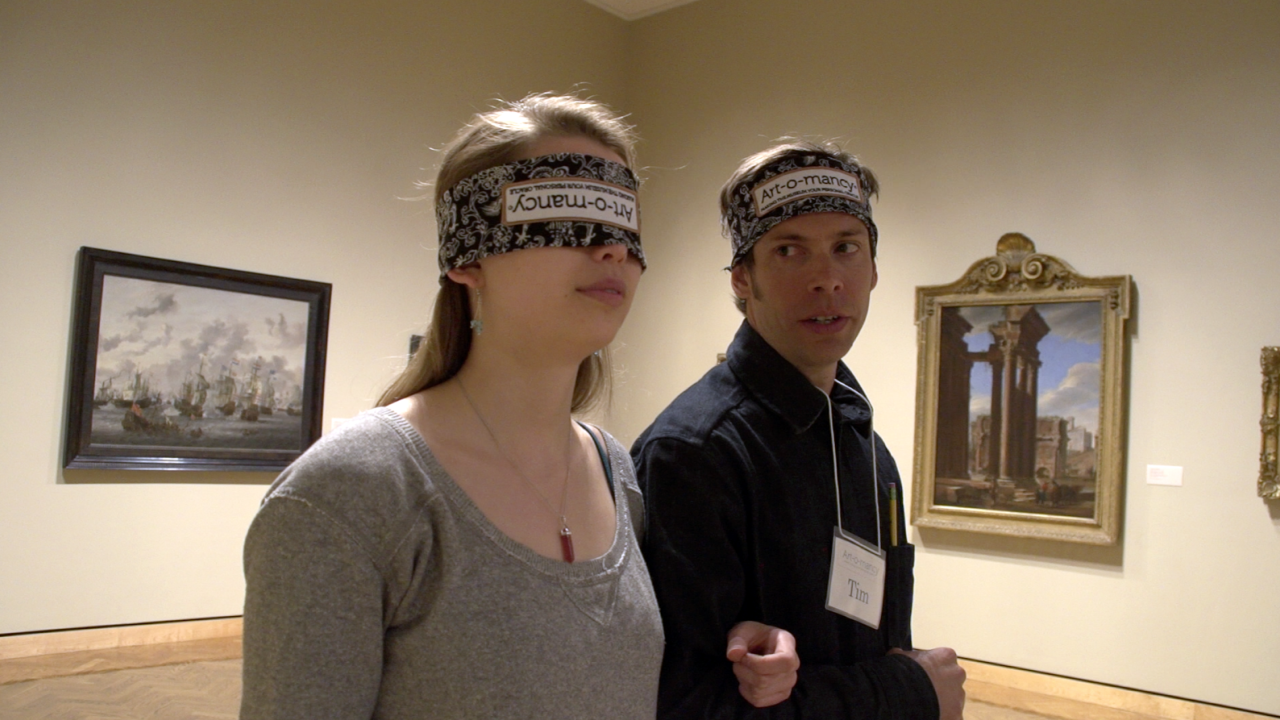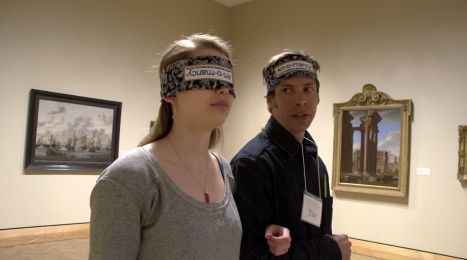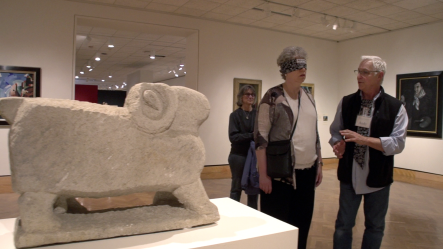
I’m always on the hunt for examples of people “hacking” museum content in interesting ways. Museum fans come up with amazing ways to use museums—things museum staff may not have thought of in a million years. This week, artist / educator / coach Laurie Phillips tells us about Art-o-mancy, a social engagement that basically turns the museum into a giant Tarot deck, co-opting museum collections as signifiers onto which seekers can project their hopes and fears.
Art-o-mancy is an experiential game that creates a new relationship between museums and museum-goers. My husband, writer and performer Jon Spayde, came up with it at the Walker Art Center in response to my boredom at mechanically looking at a painting then reading the wall description, looking, reading, looking, reading. Jon was inspired by Surrealist and Situationist games and psychogeography to try a whole different way to see art. A new paradigm was born. Since the creation of Art-o-mancy, we’ve played it in museums from San Francisco to Paris to Prague. Hundreds of people have benefited from using this sacred and fun practice to bond with art, each other, and the Muse—while getting help with some pretty gnarly life issues.
How does the game work? By turning the museum into a personal oracle.
Art-o-mancy sends the museum visitor on a multi-sensory journey anchored in the visitor’s own life. (We developed the game in art museums, but it works in just about any museum setting.)
The player, or Art-o-mancer, arrives at the museum and comes up with a question — ideally, a serious, open-ended, and significant personal question. “What do I need to know in order to succeed at my new job?” “What are the possibilities for my new relationship?” “How can I become more creative?” “What’s next for me?”

The player closes his or her eyes — or is blindfolded — and, with the help of a partner (called an Oracle Guide), uses a museum map to pick out, sight unseen, an area of the museum to begin the Art-o-mancy quest. The guide leads the questioner to that spot; during the journey the player experiences the museum with all the senses except sight—hearing the conversation of other visitors, feeling the air currents, noticing the changes in the floor surfaces, smelling historic objects or brand new installations. It’s all intended to create a kind of sleep-and-dream state that prepares the Art-o-mancer for a very personal experience.
When player and guide have arrived at the designated area of the museum, the guide invites the player to listen to his or her body. The player “tunes in” and follows whatever urge to move that he or she feels—forward, to the left or right, straight ahead. With the guide’s careful help, the player eventually feels his or her way to a stopping place, usually (but not always) in front of a work of art. The blindfold comes off.
And the work of art — or the natural history exhibit, the historical artifact, even the doorway or the window—“answers” the Art-o-mancer’s question.
How? In many ways. The imagery of a painting may deliver a direct response by indicating a course of action to follow or avoid. The dominant colors may resonate with the questioner and convey a deep meaning or a helpful mood. Details of the work’s creation or provenance may carry the weight of a response. Any- and everything about the work may be brought into play, from art history to the peculiar qualities of a certain shade of orange.
And, as we’ve discovered in playing Art-o-mancy for many years, the oracle doesn’t need to be a work of art; any objects — including fire extinguishers and wayfinding signs — can become full of meaning when a questioner really interrogates them.

The main thing is that the player, helped by the guide and any other people in the group, explores the piece with an open mind and the desire to find an answer. In that way a museum object is transformed from an impersonal cultural entity into a very personal source of wisdom and inspiration. And the museum becomes more than a site of cultural authority—it becomes the home of a work of art or culture that really “speaks to” a visitor.
Most recently, Jon and I conducted a two-hour Art-o-mancy workshop at the Minneapolis Institute of Arts, in which 17 trained Oracle Guides led 42 Art-o-mancers on a personal journey through the museum. The group included high school students, middle-aged hipsters, mothers and daughters, and older people with open minds.
We met as a large group for an introduction then split up into small groups. Each Oracle Guide took their group into the galleries and led each of them through the process described above. When we came back together as a large group, here are some of the comments made by participants:
“I learned from walking blind-folded, then looked at the art much more intensely—especially art I would usually bypass.”
“Art-o-mancy was a fun new way to experience the museum and tap into my intuition. I was dumbfounded by where I landed.”
“My question was: ‘Why is my desire for possessions never satisfied?’ I was led to Dutch artist Ary Scheffer’s painting of Christus Consolator, depicting Jesus liberating oppressed people. I interpreted this to mean that spiritual seeking provides more meaning than ‘worldly goods’ and perhaps I can have an ongoing relationship with a spiritual ‘consolatory.’”
“I liked the camaraderie, the depth of the experience along with the light-heartedness of the approach, and the overall sense of fun.”
I’d love to hear from you about your thoughts on Art-o-mancy. Could you see it working in your museum? Is it something you would like to play yourself? Please use the comments section, below, to let me know if you would like to connect with me to talk about the game.






Wow, this is such a fabulous idea. I can't wait to try it!
I love the thought of being a guide as well as participating! Having spent a good portion of my life in art museums, my 'game' has always been to intuitively connect with the artist…standing just a foot or two from a famous painting, I would let myself be filled with the emotions of the artist. This game turns that concept on its head and points it at me!
I am curious how this could be adapted to other settings where people tend to seek out to reflect, like a nature preserve or park.
Intriguing! I’m thinking of ways it could be safely adopted to our live, operating electric and/or steam railroad museums…